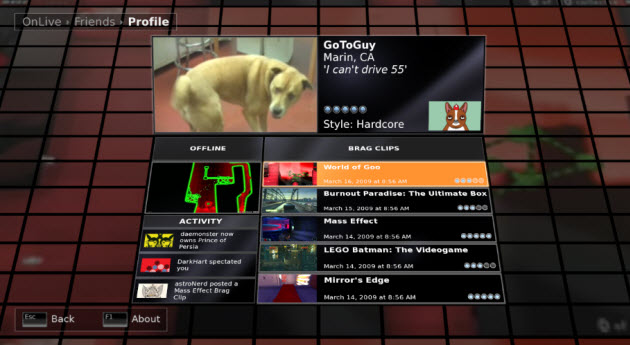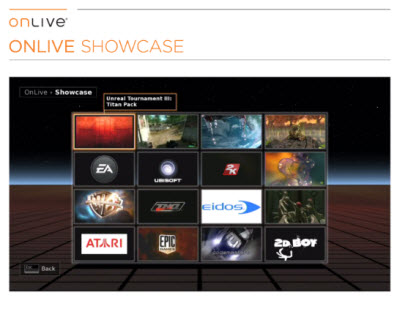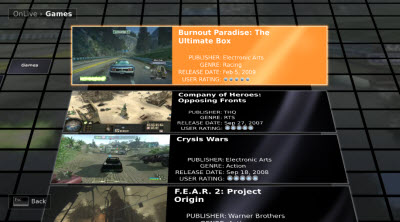 After eight years of preparation, games-on-demand startup OnLive is announcing today its plans to launch its subscription service for online games using its novel cloud-based gaming technology.
After eight years of preparation, games-on-demand startup OnLive is announcing today its plans to launch its subscription service for online games using its novel cloud-based gaming technology.
Speaking at the GamesBeat@GDC conference today, OnLive chief executive Steve Perlman said gamers will be able to subscribe to the PC or Mac games-on-demand service for $14.95 a month, and get access to a wide variety of current titles from major publishers. It is partnering in this launch with publishers including Electronic Arts, Ubisoft, 2K Games, THQ and Warner Bros. Interactive Entertainment. The games will also include new releases like Mass Effect 2, Borderlands, Assassin’s Creed II, as well as a bunch of other titles. Perlman anticipates anywhere from a dozen to 25 titles to be available at launch time, and more after that, depending on how negotiations with other publishers proceed.
 “This isn’t just older catalog games in our library,” Perlman said in an interview. “We’re going to have a lot of fresh games.”
“This isn’t just older catalog games in our library,” Perlman said in an interview. “We’re going to have a lot of fresh games.”
OnLive’s basic technology is compression, which squeezes game data into a compact form so that it can be transferred over a broadband connection to a server, where the data is computed. Then a video is sent back over the broadband line to the user’s computer. OnLive tries to make this round-trip happen so fast that the user doesn’t notice that the computing is happening in the cloud, rather than on the user’s own computer.
“This is for the user who wants instant gratification,” Perlman said. “The idea is to give gamers the same ability to enjoy something instantly as with music or video.”
The Mac version of the service will be particularly interesting, as Mac gamers have had to wait for their games for a long time after they’re published first on the PC. But OnLive will have competition on that front, as Valve announced on Monday that Mac games will be available on its digital distribution network Steam.
The Palo Alto, Calif.-based company plans to launch its consumer game service in the U.S. on June 17, during the beginning of the E3 2010 video game conference in Los Angeles. That’s later than it originally planned, but Perlman said it takes time to test a nationwide service.
 OnLive is disrupting the traditional retail distribution of high-end games, as well as high-end game hardware. It lets gamers play games almost instantaneously over a network. The network is so fast that no game downloads are necessary and the processing of graphics content happens in servers, which then send images to the user’s computer screen.
OnLive is disrupting the traditional retail distribution of high-end games, as well as high-end game hardware. It lets gamers play games almost instantaneously over a network. The network is so fast that no game downloads are necessary and the processing of graphics content happens in servers, which then send images to the user’s computer screen.
 Gamers can buy and start playing a game almost instantly; that upsets the retail market. Meanwhile, since the heavy-duty processing takes place in servers in a data center, OnLive allows gamers to play on relatively simple hardware. You could play a high-end game like Crysis on a netbook or laptop without heavy-duty 3-D graphics chips in them. Or, you could use a Micro Console TV Adapter from OnLive, which converts the images so they can be displayed on a screen; hence, you could play a high-end PC game on your TV set, using only the Micro Console.
Gamers can buy and start playing a game almost instantly; that upsets the retail market. Meanwhile, since the heavy-duty processing takes place in servers in a data center, OnLive allows gamers to play on relatively simple hardware. You could play a high-end game like Crysis on a netbook or laptop without heavy-duty 3-D graphics chips in them. Or, you could use a Micro Console TV Adapter from OnLive, which converts the images so they can be displayed on a screen; hence, you could play a high-end PC game on your TV set, using only the Micro Console.
When the company announced its general games-as-a-service plan a year ago, many were skeptical. And OnLive has fallen behind its original schedule; it will launch in June instead of the winter of 2009-2010 as Perlman first said. But point by point, Perlman has dealt with the criticism.
Last summer, for instance, he rounded up the capital needed to deploy the network from AT&T and Lauder Partners. Other backers include Maverick Capital, Autodesk, and Warner Bros. Interactive Entertainment. While he didn’t announce the funding amount, Perlman said the money was more than enough to allow OnLive to fully test its system and launch when it was ready.
Last fall, the company began an online beta test. At the Dice Summit, Perlman showed the system working live before an audience of hundreds. Perlman also planned to show the service off at GamesBeat@GDC. The company plans to extend its beta test to another 25,000 users now.
The OnLive Game Service will let gamers discover, explore, purchase and play video games. Much like the Netflix DVD rental service’s online component, it lets you play games on the network instantly. You simply click on an icon for a game and it launches over the broadband connection.
 The OnLive service will include online game service features much like Microsoft’s Xbox Live service for the Xbox 360. You can have your own permanent gamer tag (identification), user profiles, friends, chat, and the ability to challenge friends in multiplayer matches. The company’s Brag Clips feature records your online game matches and lets others watch them as videos. You can pause and resume a game, even on a different platform. Games can be purchased or rented, with actual per game pricing to be announced at E3.
The OnLive service will include online game service features much like Microsoft’s Xbox Live service for the Xbox 360. You can have your own permanent gamer tag (identification), user profiles, friends, chat, and the ability to challenge friends in multiplayer matches. The company’s Brag Clips feature records your online game matches and lets others watch them as videos. You can pause and resume a game, even on a different platform. Games can be purchased or rented, with actual per game pricing to be announced at E3.
Other big titles include Dragon Age Origins, Prince of Persia: The Forgotten Sands, and Metro 2033. By June, some of these games will be old. But Perlman said more games will be announced over time. The MicroConsole TV Adapter won’t be available in June, but will ship later in the year.
Perlman said that the company’s 100-plus employees have been toiling away at building the network across five different data centers and then testing it. The service can’t suffer from delays, known as lag, or gamers will complain loudly. That’s also why OnLive is expanding the service little by little.
 If it works, then the company will transform games. There’s still a lot of ifs, but not as many as there were a year ago. There are also rivals such as Otoy, Gaikai, Valve and others trying to do different variations on the same theme of cloud-based gaming.
If it works, then the company will transform games. There’s still a lot of ifs, but not as many as there were a year ago. There are also rivals such as Otoy, Gaikai, Valve and others trying to do different variations on the same theme of cloud-based gaming.
OnLive will be telling developers how they can create games that can be released on its network at the GDC. Perlman said it took one THQ engineer about three weeks to port the first title to run on OnLive. The games have to modified for various things they do different than in a console game; for instance, they don’t have to sign someone into a company game network or initiate a digital rights management authentication, as a user does when they log into the OnLive service. So some of those functions have to be turned off in a game in order to make them run. As for building out the OnLive network, it took eight years to design it and then roll it out, “rack by rack,” Perlman said.
“If you do something with huge potential scale, that takes a lot more work,” Perlman said. “Some things turned out better than we expected. Some things worse. There was a time when we thought we would have to come out at a much higher price. That isn’t the case. Overall, it’s a net positive.”
“We are following through on our goal of disruption,” Perlman said. “Some skeptics said we were violating the laws of physics. Some said it would be easy. Some said it wouldn’t be practical. We have seen that it is hard and complex. ”
So far, hundreds of thousands of people have put in their requests to get service. The initial service will be available in high-definition at 720p. To do 1080p resolution, Perlman said it will take time, perhaps not until 2011. As for the competitors, Perlman said, “We haven’t seen anyone else come out ahead of us. The question is what games are they going to get.”
Read all our coverage from GamesBeat@GDC.
VentureBeat's mission is to be a digital town square for technical decision-makers to gain knowledge about transformative enterprise technology and transact. Learn More
